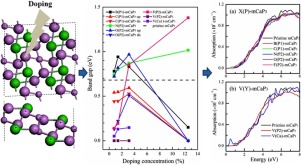Materials Today Communications ( IF 3.8 ) Pub Date : 2020-01-14 , DOI: 10.1016/j.mtcomm.2020.100925 Zhongjun Li , Mingzhi Qian , Honglian Zhao , Dong Zhang , Bing Chen , Huaili Qiu , Ting Zhang

|
Monolayer CaP3 (mCaP3), a semiconductor predicted theoretically with suitable band gap and high electron mobility, shows potential applications in nanoelectronics and optoelectronics. In this work, using first-principles calculations, diverse electronic, magnetic and optical properties of mCaP3 were explored by substituting P atoms by B, C, N, O and F or introducing P and Ca vacancy, respectively. The results show that B and C prefer to substitute P atoms (denoted by P1) bonding with four adjacent P atoms, while N, O and F tend to substitute P (denoted by P2) bonding with two P and two Ca atoms. These two types of systems, expressed by X(P1)-mCaP3 (X B and C) and X(P2)-mCaP3 (X
B and C) and X(P2)-mCaP3 (X N, O and F), are favorable in energy. The systems of B(P1)-mCaP3, N(P2)-mCaP3 and F(P2)-mCaP3 with four different doping concentrations are found to be spin-non-polarized semiconductors. Notably, in N(P2)-mCaP3 and F(P2)-mCaP3, the band-gap is monotonically tuned by changing doping concentrations. In contrast, in C(P1)-mCaP3 and O(P2)-mCaP3, the spin-polarized semiconducting characters are obtained at the two low doping concentrations, and the transition from semiconducting to metallic states appears at the highest doping concentrations. Besides the tunable band gaps obtained, good optical absorption features in entire visible-light range are kept in all doped systems as the pristine one. In particular, an additional absorption peak in low energy region is induced by Ca vacancy and P substitution by C. These diverse electronic, magnetic and optical properties obtained by selective doping in mCaP3 will expand its potentials in future applications.
N, O and F), are favorable in energy. The systems of B(P1)-mCaP3, N(P2)-mCaP3 and F(P2)-mCaP3 with four different doping concentrations are found to be spin-non-polarized semiconductors. Notably, in N(P2)-mCaP3 and F(P2)-mCaP3, the band-gap is monotonically tuned by changing doping concentrations. In contrast, in C(P1)-mCaP3 and O(P2)-mCaP3, the spin-polarized semiconducting characters are obtained at the two low doping concentrations, and the transition from semiconducting to metallic states appears at the highest doping concentrations. Besides the tunable band gaps obtained, good optical absorption features in entire visible-light range are kept in all doped systems as the pristine one. In particular, an additional absorption peak in low energy region is induced by Ca vacancy and P substitution by C. These diverse electronic, magnetic and optical properties obtained by selective doping in mCaP3 will expand its potentials in future applications.
中文翻译:

缺陷诱导的单层CaP 3的各种电子,磁性和光学性质
从理论上预测具有合适的带隙和高电子迁移率的半导体单层CaP 3(mCaP 3)在纳米电子学和光电子学中显示出潜在的应用。在这项工作中,使用第一性原理计算,通过分别用B,C,N,O和F取代P原子或引入P和Ca的空位,探索了mCaP 3的各种电子,磁性和光学性质。结果表明,B和C倾向于用两个相邻的P原子取代P原子(用P1表示),而N,O和F倾向于用两个P和两个Ca原子取代P(用P2表示)。这两种类型的系统分别由X(P1)-mCaP 3(X  B和C)和X(P2)-mCaP 3(X
B和C)和X(P2)-mCaP 3(X N,O和F)在能量上是有利的。发现具有四种不同掺杂浓度的B(P1)-mCaP 3,N(P2)-mCaP 3和F(P2)-mCaP 3的体系是自旋非极化半导体。值得注意的是,在N(P2)-mCaP 3和F(P2)-mCaP 3中,带隙通过改变掺杂浓度而单调调谐。相反,在C(P1)-mCaP 3和O(P2)-mCaP 3中,在两个低掺杂浓度下获得了自旋极化的半导体特性,并且在最高掺杂浓度下出现了从半导体到金属态的转变。除了获得可调节的带隙外,在所有掺杂系统中都保持原始的状态,在整个可见光范围内都具有良好的光吸收特性。尤其是,Ca空位和C取代P会在低能区引起一个额外的吸收峰。通过在mCaP 3中选择性掺杂而获得的这些多样化的电子,磁性和光学性质将扩展其在未来应用中的潜力。
N,O和F)在能量上是有利的。发现具有四种不同掺杂浓度的B(P1)-mCaP 3,N(P2)-mCaP 3和F(P2)-mCaP 3的体系是自旋非极化半导体。值得注意的是,在N(P2)-mCaP 3和F(P2)-mCaP 3中,带隙通过改变掺杂浓度而单调调谐。相反,在C(P1)-mCaP 3和O(P2)-mCaP 3中,在两个低掺杂浓度下获得了自旋极化的半导体特性,并且在最高掺杂浓度下出现了从半导体到金属态的转变。除了获得可调节的带隙外,在所有掺杂系统中都保持原始的状态,在整个可见光范围内都具有良好的光吸收特性。尤其是,Ca空位和C取代P会在低能区引起一个额外的吸收峰。通过在mCaP 3中选择性掺杂而获得的这些多样化的电子,磁性和光学性质将扩展其在未来应用中的潜力。



























 京公网安备 11010802027423号
京公网安备 11010802027423号